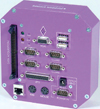
The Buckeye Bullet is an electric vehicle student project at The Ohio State University’s Center for Automotive Research. The ‘Bullet’, as the team calls it, became the first electric-powered vehicle in the world to exceed 300 mph (480 km/h) when it reached a top speed of 496 km/h on 16 August , 2004, during the 56th annual Speed Week at the Bonneville Salt Flats in Utah.

Subsequently, on 14 October, at the end of mile 5, this was raised to 506,8 km/h, which qualified as a new US record in one direction. The vehicle has since achieved speeds as high as 517,9 km/h.
The Buckeye Bullet (www.buckeyebullet.com) uses Diamond Systems' (www.diamondsystems.com) Prometheus PC/104 CPU with its embedded Linux Development Kit and Jupiter-MM-LP power supply to monitor several critical systems in the vehicle. The CPU and power supply are housed in the rugged Pandora enclosure, which ensures the system is protected under extreme racing conditions.

For several years the Buckeye Bullet had been using a racing electronics system that sampled data at a slow 10 Hz. This older technology worked well for running a smaller car around a track, but not so well for a 506 km/h 'laboratory on wheels', as the Buckeye Bullet has been described. The team wanted to monitor different sensors at different times during live vehicle operation. Switching to the PC/104 platform made sense because it was rugged, compact, low-power, and easy to customise and expand.
The first measurements made with the Prometheus CPU were the brake-pad temperatures. When running a car at such speeds, coming to a stop from such a high rate of speed is just as difficult a challenge as reaching that speed. The team found that disk brakes were only useable up to approximately 193 km/h due to excessive heat generation from the high wheel rotation rates. They added two parachutes, a high-speed chute and a low speed chute, which are activated at different times at the end of a run to slow the Bullet to the point where normal brakes can take over. The Bullet team wanted to measure brake pad temperatures to help them select the optimum type of pads. This was done by embedding thermocouples directly in the pads themselves. After several rounds of measurements, the team found that the pads were reaching temperatures as high as 538°C quite quickly. They then were able to validate their selection of brake pads and ensure safe and reliable stopping capability.
The team began adding on other sensors, including gathering telemetry from their power inverter, which generates valuable information about the performance of the power system on the vehicle. They also added a 3-axis, digital accelerometer to be able to monitor vibrations on the chassis while running, as well as to measure the g-forces that the driver felt during acceleration and deceleration. The team is currently in the process of incorporating battery temperature monitors, steering movement, driveline strain gauges, and transmission sensors into the system to determine exactly what happens during a run, so they can improve performance in future designs.
The Linux implementation also has key advantages for the Buckeye Bullet team. "Being able to use a secure shell from the PC/104 CPU made it almost unnecessary to ever have to access the box itself", said Buckeye Bullet team member Kevin Ponziani. "This made for a very easy to use system, and made it even easier to update the software."
| Tel: | +27 12 493 0852 |
| Email: | [email protected] |
| www: | www.epd.co.za |
| Articles: | More information and articles about Electronic Products Design |

© Technews Publishing (Pty) Ltd | All Rights Reserved